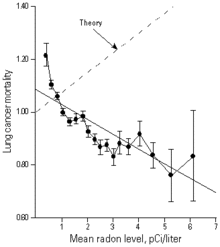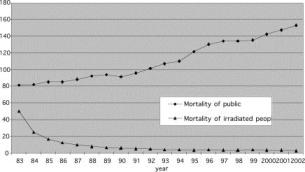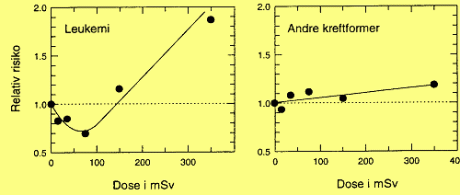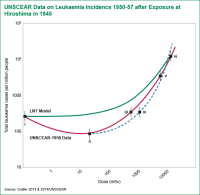Og.klik påb For sources and references:
Og.klik påb Click on the yellow and see if you get useful details.
Og.klik påb Click on pictures for more details.
_______________________________________________________________________
Background for the writings below
Next to religion, little has been discussed with so many preconceptions as radiation hormesis. (The claim of benefits from moderate exposure to radiation)
In most evaluations of danger of exposure to (manmade) radiation, it is taken for granted that the Linear, No Threshold assumption should be used. ( LNT or “No matter how little – it is dangerous”)
However, this assumption is only based upon extrapolation of knowledge related to danger from doses of radiation considerably higher than the usual exposure to radiation, as referred to in the following.
In the meantime too much available evidence points in the other direction.
The following does not include any new findings, but is an attempt to give something like a review of the most important writings found, mainly on the internet.
The validity of the many claims, can somehow be established by noting that even after a prolonged search on the internet and following, sometimes heated, debates on internet-media, there has not been found any FACTURAL reservations.
On this page from Wikipedia you will find a good revue.
If you have any comments, reservations or suggestions: Please write to me on thorkilsoee@gmail.com
Hormesis in general
It is well known that: ‘The doze makes the poison’.
But also: In many countries fluorine is added to toothpaste.
However, in some locations, as in East Africa, the quantities make it into a harmful pollution to otherwise clean drinking water.
Similarly, moderate sunbathing is beneficial, but too much will be harmful.
Most Telling Findings
T. D. Luckey
T. D. Luckey, who may be regarded as ‘the grand old man’, has dedicated his research to radiation hormesis.
In this paper there are references to an enormous amount of research.
 Some of the most important findings may be:
Some of the most important findings may be:
- Negative correlation between cancer and exposure to Radon in USA.
- Health and reproduction of animals improved markedly by radiation.
- Therapeutic use of Radon in USSR.
- Studies of workers in the nuclear industry.
The Taipei incident
Many references have been made to the Taipei incident, where approximately 10,000 people were accidentally exposed to doses of radiation well above what usually is regarded as acceptable.
The findings include:
- Cancer deaths only 3 % of what could expected, if LNT is used.
- Congenital malformations (defects present at birth) only 7 % of expected.
- Initial decrease in cancer rates among the exposed population.
 Although the age of the exposed population is less than for the control, the initial drop in cancer rate eliminates the immediate objection assuming “The Healthy Workers”.
Although the age of the exposed population is less than for the control, the initial drop in cancer rate eliminates the immediate objection assuming “The Healthy Workers”.

From a long and very informative e-book
Stråling og helse (in Norwegian) you will get a lot of useful information about radiation.
Eg. the graph above showing Radiation Hormesis for leukemi, but not for other forms of cancer.
- You can click for the full English edition.
325 pages of very informative text.
Here you will find a lot of relevant subjects and it is written in a not too difficult language.
You can jump using the usual search: Ctrl+F
Also, in the Norwegian study, it is shown how the ability to resist radiation is significantly increased if the cells are given a “Break to Recover” halfway into an otherwise deadly dosage.
This has been shown in cell-cultures and on animals.
But of course not on humans.
Wikipedia gives a more restrained picture.
Still I dare to say that:
The natural conclusion will be that these findings can only be dismissed if assuming forgery.
Rasmar
The Rasmar case, as commented on below, originally puzzled the scientific community, and gave name to the term “The Rasmar Paradox”.
Areas with high natural background radiation
Most noted is the area around Rasmar in Iran where a relative little population has lived for generations, exposed to very high levels of radiation from radon.
However there has not been reported ill health.
Genetic adaptation may explain something.
Several other locations have similar, but smaller exposure:
- Guarapari (Brazil)
- Cumuruxatiba (Brazil)
- Kerala (India)
- Karunagappall (India)
- Arkaroola (South Australia)
- Yangjiang (China)
- Black Beach (Brazil – uninhabited)
Here it has been difficult to find conclusions from data available.
Further it can be noted, that People living in Colorado and Wyoming have twice the annual dose of radiation as those in Los Angeles, but have lower cancer rates.
However, there may be other reasons.
Nuclear bomb survivors.
Some, slightly conflicting, information is available:
From World Nuclear: (Click for the appendix)
 Among survives exposed to about 20 mSv, 92 people per million developed leukaemia, (ii)
Among survives exposed to about 20 mSv, 92 people per million developed leukaemia, (ii)
Compared to the control group, where 273 people per million developed leukaemia. (i)
For those exposed to higher levels of radiation (op to 500 mSv), 398 people per million developed leukaemia.
(iii and iv)
Among those receiving a near fatal dose (about 5000 mSv), more than 5000 people per million developed leukaemia. (v)
The green line refers to the LNT-hypothesis. This line would have been a straight line if the scale used had not been logarithmic.
Later (2018) we get a sort of an update, also from World Nuclear.
blankSome 65 years after the acute exposure it can be seen that
blankCancer rate in the irradiated survivors is lower than the controls
blankand lower than in the Japanese population as a whole.
from The Lancet
A very comprehensive survey by John B Cologne and Dale L Preston has been published in The Lancet Volume 356 – June 22, 2000
Here the following is concluded:
- Indications of radiation hormesis are so insubstantial that conclusions cannot be drawn.
- Nothing is written about chronic radiation sicknesses or congenital malformations.
- There are indications for a threshold in such a way, that exposure below 500 mSv has not resulted in damages in form of shorter life expectation.
(500 mSv is some 100 times what is usually allowed in the nuclear industry) - The relatively few survivors exposed to 3500 mSv, which is about the threshold for death from acute radiation sickness, had a statistical life shortening of 3 years.
Nuclear accidents.
Chernobyl (1986)
Short after the accident there were so many conflicting “findings” that a conclusion could not be drawn.
In 2006 BBC published a paper titled Chernobyl’s ‘nuclear nightmares’. Here experience from Chernobyl and Hiroshima was analyzed and it was showed that the nightmares and the LNT-hypothesis could not be sustained.
However, it was not enough to change the public mis-understandings.
Some “new” findings, and especially the comments, found in
The Guardian (2015) give a good picture of the lack of public acceptance.
Even Der Spiegel starts to ask: Is Radiation As Bad As We Thought?
2018 25. jan. you see that UNSCEAR has downgraded the death toll in relation to the disaster at Chernobyl from 4000 to “Almost Zero”
As this downgrade has been questioned, I refer to the following link where I have tried to make a summary and evaluation of available and trustworthy information.
¨….If you read this link Greenpeace’s Credibility is a Myth, it is easy to see
…..why information from Greenpeace has not been included.
Fukushima (2011)
A very comprehensive paper by John E. Ten Hoevea and Mark Z. Jacobson: Worldwide health effects of the Fukushima Daiichi nuclear accident, has been published by The Royal Society of Chemistry 2012, in the section Energy & Environmental Science
(Cite: DOI: 10.1039/c2ee22019a)
In connection with a general analysis of risks from nuclear accidents, the following conclusion is found:
“The prolonged mandatory evacuation caused more deaths (from fatigue or aggravation of chronic illness), than deaths from radiation, saved by the evacuation.”
It is stressed, that the LNT hypothesis has been used although a more accurate assumption would have yielded much more telling results.
Also here, nothing is written about chronic radiation sickness or congenital malformations.
More can be found in relation to the discussion J-value or Justification value.
The Radium Girls
Around year 1910 radium was introduced for self-illuminating paint.
Some 4,000 girls worked with the radium, many became sick and an unknown number died.
The studies described on http://en.wikipedia.org/wiki/Radium_Girls and http://www.rerowland.com/dial_painters.htm show the incredible neglect of human health, but also how lowering the exposure eliminated the risk.
My own conclusions
More research
From several years at different universities, I have learned the following, which I present in a rather negative form.
- Research, write or die.
Just write something about something, and get promoted. - Do not go against the establishment.
Or “Do not pie against the wind.” - The quality of most papers found, reflects the above.
In relation to radiation hormesis, it has been brought forward, that we should “just wait” for the result of a planned research related to animals living under extremely low levels of radiation.
Short term exposure contra long term exposure
It is well known, that it will be harmful to take your yearly intake of vitamins in one dose.
It is my opinion that, when dealing with radiation hormesis, too little attention has been given to the similar.
Sins from the past
Health of people has often been grossly neglected and important facts have been hidden in search of economic gains.
Most notably will probably be:
- Health risks related to use of tobacco.
- Risk of lung cancer and other diseases related to use of asbestos.
- Talidomil (1957)
- And now (2019) even the safety of aircrafts.
In this way, it is easy to understand how there is a lot of doubt about the validity of the findings, of which the above are only a minor part.
Almost hopeless discussions
When trying to get a meaningful discussion about the evacuations after the Fukushima accident the following should have been brought forward:
- It would be irresponsible to send people back to an area, which may be dangerous.
- It would also be irresponsible to keep people as refugees from their homes, if it is not necessary.
- It is even much more irresponsible that the scientific community do not make a detailed research in the matter and find the through.
Even if it would result in some authorities have to swallow the bitter pill and accept unpleasant findings.
Instead of considering something like this, everything tends to end up in a meaningless exchange of undocumented postulation.
Much later it is found that all the evacuations after the accident at Fukushima were not justified by anything but panic.
In this way harmful.
However
You will also find apparently reliable information supporting the LNT hypoteses.
(1 Rad = 0.010 Gy or about 0.20 Milli-Sivert.)
What should be done
It is my belief, that we do not need more of the usual research.
My opinion is that we need an open and independent evaluation of existing knowledge.
It should be possible to:
- Find qualified person(s), who can make a sort of bridge between the two different extreme: The almost fundamentality based opinions “for” and “against”.
- Evaluate existing findings, including at least two books, and almost force the extreme parties to a sort of a consensus.
- If thereafter approved, agree and arrange for tests using unquestionably informed volunteers participating in a well-documented investigation into the effect of different doses of radiation.
It should be noted that now, as well as long before radon and radioactivity was known, health seekers are frequenting locations, where they receive “radon-treatment” for all types of illnesses.
Postscript
If you are interested in more, I have written quite a lot.
Mainly about the many falsified pieces of “information” related to imaginated risk in relation to nuclear power and radiation.
On a post from The Energy Collective you can find an interesting discussion titled Radiation and Reason.
- Radon and more.
Here the “more” is about the ridiculous claims related to pollution of the ocean after the nuclear accidents at Fukushima. - Greenpeace and nuclear.
Here I show that Greenpeace’s Credibility is a Myth.
At least when it comes to “information” about Nuclear Energy. - No harm to next generation.
It came as a surprise to me, and it will probably come as a surprise to many, that there has not been any kind of genetic damage to the descendants of persons who have been exposed to even very high levels of ionizing radiation. - Måske kommer der noget
Alzheimers disease! - Of course you find useful information provided by
Wikipedia.
Evacuations
After the accidents at Chernobyl and Fukushima there were many compulsory evacuations.
These evacuations resulted in a lot of suffering and thousands of deaths.
Even manly suisides.
The nagging question: “Were these evacuations justified?”
This question has finally been taken up considering J-value or Justification-value.
It may come as a surprise to many that the answer came out to be:
“Almost no justification.”
As mentioned elsewhere, I dare to put the blame for this unnecessary suffering on Greenpeace and other scaremongers.
Goiania, Brazil (1987)
An abandoned radioactive source was taken from a hospital.
It was opened and handled without understanding.
“Overall 249 people were found to have significant levels of radioactive material in their bodies.
– – “In the 25 years since 1987 there have been zero cancers from radiation among those 249 people affected at Goiania.
In spite of the ingestion of up to 100 MBq giving doses as high as
625 mSv/month.”
Radiation Hormesis is not mentioned in the paper.
Still I dare to claim that the absence of cancer among so many people for 25 years is a strong indication of “Something”
bla1000 mSv/year
blankFollowing information, mostly from Videnskab.dk,
blank1000 mSv/year gives the organism time to recover without harm.
blankThis has been disputed by anti-nuclear activists.
blankHere we see that five times as much has been tolerated.
“Eight individuals had higher activity than 100 MBq internally.
Of these 4 died of acute radiation syndrome but none of cancer.
Two healthy babies were born, one to a mother among the most highly contaminated.”
Bq is the unit for radioactive decay per sekund.
It is a very little unit.
Without being contaminated, all of us are exposed to about 4,000 Bq
So 100 MBq (100,000,000 Bq) is still quite a lot.
1 Gy = 1 Sv without adjustment (upward) for sensibility of different tissues.
If exposed to short-term radiation 1 Sv can be live-tharetning and there is little chance of surviving 4 Sv
This applies for short time exposure, as with accidents or nuclear bombs.
Nothing is found about the timescale, but most of the people were exposed to – and survived – due to fractional exposure.
The Cleanup Operation
But the cleanup operation showed that NOW something should be done.
In my opinion it highlights the conflict between real and assumed danger.
blank“In the cleanup operation, topsoil had to be removed from several
blanksites, and several houses were demolished.
blankAll the objects from within those houses, including personal
blankpossessions, were seized and incinerated”
There is no information about handeling of the ashes.
Der Spiegel
A long paper from Der Spiegel (April 26, 2016) indicates that several researchers try to investigate seriously.
Die Springer
Thanks to Ikemeister for alerting me to a long and interesting link to die Springer.
What doesn’t kill us makes us stronger, said philosopher
Friedrich Nietzsche.
From Atomic Inssights 2017 August, I quote:
Excessive regulation of extremely low radiation doses increases the public fears of nuclear technology, increases the costs borne by society, and can deprive society of the full benefit of that technology.”
I dare to continue saying: Destroying the climate, pretending to save it.
A long internet-paper, also from Atomic Insights, gives interesting information. (October 24, 2018)
I quote from this paper:
Several of those experiments indicated that the radiation doses stimulated repair and recovery responses to such an extent that cellular damage done by agents other than radiation was also repaired, making the cell healthier after receiving a small to moderate dose of radiation.
Compared to what it was before exposure.
If this information is to be trusted, it will lift the veil surrounding much of the apparent conflicting information.
From a very comprehensive Norwegian study:
” – – Low doses of radiation do not “look to be” dangerous.
” – – A lot of new research points in the direction that low doses of
bfrila radiation is beneficial.
” – – To “calculate” that there will be 500 extra deaths [from Chernobyl]
bfrila from cancer in Norway is 100 % not serious and unethical.
AND
” – – In China, there are two large groups of people living in areas where bfrila the natural background radiation varies by a factor of 3.
” – – If one compares these with respect to cancer death, it turns out that bfrila those living in the low-dose area have the greatest risk.
” – – This clearly shows the problems we are struggling with in
bfrila determining the dose effect curve for the low dose.
A long article concentrating on positive aspects.
Dear unknown reader
This post deals with a subject which includes many pieces of information, some may be regarded as false.
Therefore, if you have factual information which should lead to corrections or aditions.
Don’t hesitate to write to me thorkilsoee@gmail.com
.Index
Planed
An extremely sober and interesting collection! Hope it will be useful in most of the world. Probably Europe is lost to the green phantasts.
Very good collection! I’ve bookmarked it for future reference. A couple of points:
A typo? Do not pie against the wind.” 😉
I have found http://link.springer.com/article/10.1007/s13752-016-0244-4 to be great summary of the case agaist LNT I recommend you reference here.
Compelling. One correction – it is Ramsar and it is in Iran not Pakistan
Hi, this might be random, but where did you get the Html template for this website? Thank you.